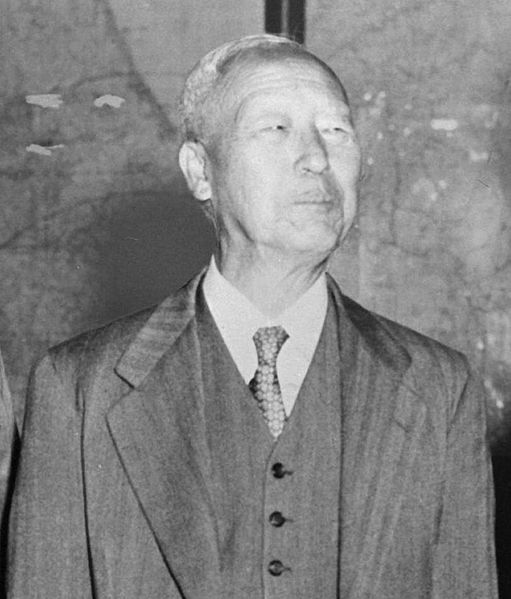<Back to Index>
- Mathematician Paul Erdös, 1913
- Playwright Tennessee Williams, 1911
- First President of the Republic of Korea Syngman Rhee, 1875

Syngman Rhee or Yi Seungman (March 26, 1875 – July 19, 1965) was the first president of South Korea. His presidency, from August 1948 to April 1960, remains controversial, affected by Cold War tensions on the Korean peninsula and elsewhere. Rhee was regarded as an anti-Communist and a strongman, and led South Korea through the Korean War. His presidency ended in resignation following popular protests against a disputed election. He died in exile in Hawaii.
Syngman Rhee was born in Hwanghae Province to Yi Gyeong-seon, a royal aristocrat. By birth, Rhee was a member of a royal cadet branch of the House of Yi, the House of Grand Prince Royal Yangnyeong. He attended Pai Chai Hak Dang but he soon became active in Korea's struggle against Japanese hegemony. He was arrested in 1897 for demonstrating against the Japanese monarchy, being subsequently released in 1904 and going to the United States. He obtained several degrees (including a B.A. from George Washington University, Harvard University, and a Ph.D. from Princeton University) and became so Westernized that he began writing his name in the Western manner, with the personal name preceding the family name.
In
1910, he returned to Korea, which had by this time been annexed by
Japan. His political activism attracted unwelcome attention from the
occupying army. In 1919, all of the major pro-independence factions
formed the Provisional Government in Shanghai.
Rhee was elected the president, a post he held for six years, until
1925 when he was impeached by the Provisional Assembly for misuse of
his authority. After Japanese rule ended in Korea, Rhee returned to Seoul before
the other independence leaders, since he was the only one well known to
the Allies. In 1945, he was appointed head of the Korean government
with strong backing by the United States. With the tacit consent of the
occupation authorities, Rhee conducted a campaign to "remove Communism"
that was actually a veiled drive to remove all potential opposition. Rhee won a seat at the First Assembly of South Korea on 10 May 1948 by a parliamentary vote after left-wing parties boycotted the election. After being elected as the Speaker of the Constituent Assembly on May 31, Rhee was elected the first president of South Korea defeating Kim Gu,
the last president of the Provisional Government by a count of 182-13
on 20 July 1948. It should be noted that Kim Gu was not aware of his
nomination for presidency; the nomination was likely an attempt to
discredit him as a nationalist. On 15 August 1948, he formally took
over power from the US military and de jure sovereignty of Korean
people from the Provisional Government. As president, Rhee assumed dictatorial powers even before the Korean War broke out in 1950. He allowed the internal security force (headed by his right-hand man, Kim Chang-ryong) to detain and torture suspected Communists and North Korean agents. His government also oversaw several massacres, the most notable one being on Jeju island in which over 30,000 where killed in response to an uprising by leftist factions. South Korea's Truth and Reconciliation Commission has
estimated that the number of deaths attributed to these killings is at
least 100,000 and perhaps upwards of 200,000. Rhee further damaged his
reputation by encouraging the citizens of Seoul,
the nation's capital, to remain in the city while he himself was
already on his way to refuge as war broke out. His decision to cut the
bridges on the Han River prevented thousands of citizens from escaping Communist rule. When UN and South Korean forces fought back and drove the North Koreans north towards the Yalu River (only to retreat to a line around the current DMZ because of Chinese counterattack),
Rhee became unpopular with his allies for refusing to agree to a number
of ceasefire proposals that would have left Korea divided. Hoping to
become the leader of a united Korea, with U.N. assistance, he tried to
veto any peace plan that failed to eliminate the northern government
completely. He also argued for stronger methods to be used against
China and often expressed annoyance at the reluctance of the U.S. to
bomb it. Following the Korean War and for the remainder of his rule, he kept imprisoned the Dowager Queen Yun Empress Sunjeong of the Korean Empire in Suin Hall, a cottage in Jeongneung, Seoul, for fear of the respect the people held for her, and he attempted to claim he was related to the royal Yi family. In
1960, Rhee assured his fourth term in office as President with a
resounding 90% of the vote. The landslide victory came after the main
opposition candidate, Cho Byeong-ok, died shortly before the March 15 elections. Nevertheless Rhee was determined to see his protégé Lee Gibung elected
as the independent Vice President - a separate office under Korean law
at that time. But when Lee, who was running against Chang Myon,
former ambassador to the United States during the Korean War, won the
vote with an abnormally wide margin, the opposition claimed the election
was rigged. This triggered anger among segments of the Korean populace.
When police shot demonstrators in Masan, the student-led April 19 Movement forced Rhee to resign on April 26. On April 28, a DC-4 belonging to the United States Central Intelligence Agency - operated by Civil Air Transport - whisked Rhee out of South Korea as protestors converged on the Blue House. It was later revealed by Kim Yong Kap, Deputy Minister of Finance, that Rhee had embezzled more than $20 million in government funds. The former president, his Austrian-born wife, Franziska Donner, and adopted son then lived in exile in Honolulu, Hawaii. On July 19, 1965, Rhee died of a stroke. His body was returned to Seoul and buried in the Seoul National Cemetery on July 27 that same year.